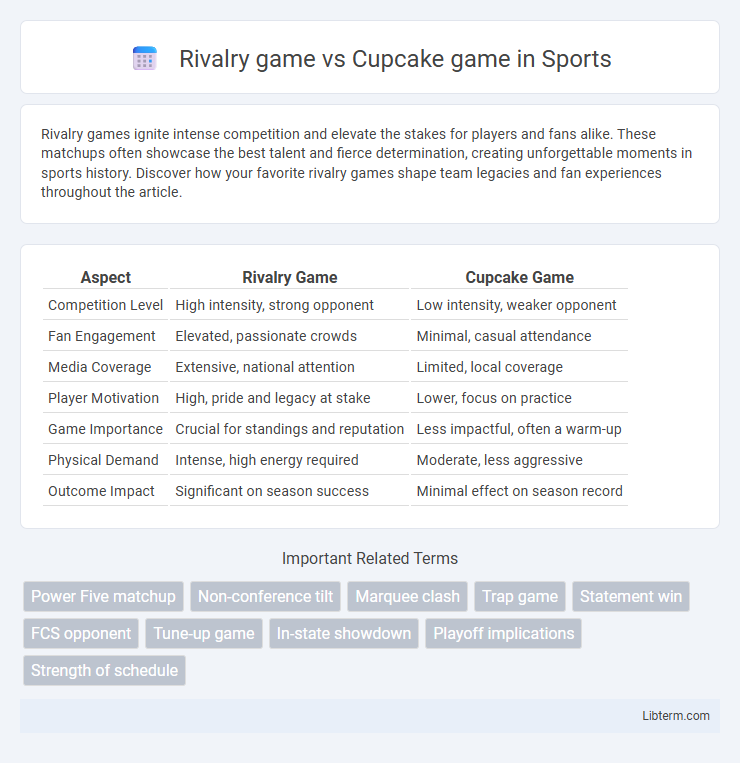Rivalry games ignite intense competition and elevate the stakes for players and fans alike. These matchups often showcase the best talent and fierce determination, creating unforgettable moments in sports history. Discover how your favorite rivalry games shape team legacies and fan experiences throughout the article.
Table of Comparison
| Aspect | Rivalry Game | Cupcake Game |
|---|---|---|
| Competition Level | High intensity, strong opponent | Low intensity, weaker opponent |
| Fan Engagement | Elevated, passionate crowds | Minimal, casual attendance |
| Media Coverage | Extensive, national attention | Limited, local coverage |
| Player Motivation | High, pride and legacy at stake | Lower, focus on practice |
| Game Importance | Crucial for standings and reputation | Less impactful, often a warm-up |
| Physical Demand | Intense, high energy required | Moderate, less aggressive |
| Outcome Impact | Significant on season success | Minimal effect on season record |
Defining Rivalry Games and Cupcake Games
Rivalry games are intense competitions between teams or individuals with a long-standing history and high emotional stakes, often marked by balanced skill levels and passionate fanbases. Cupcake games refer to matchups where a dominant team faces a significantly weaker opponent, leading to predictable and one-sided outcomes. Defining these games involves analyzing factors like historical context, competitive balance, and fan engagement to understand their impact on sports culture.
The Emotional Stakes: Fans and Players
Rivalry games ignite intense emotional stakes for fans and players, fueled by decades of competition and local pride that amplify every play and decision. The deep-rooted histories and personal connections create high-pressure moments where the outcome influences community morale and player legacies. Unlike the casual atmosphere of Cupcake games, rivalry matchups command peak focus and passion, making each goal or turnover a pivotal event charged with emotional significance.
Historical Context of Rivalry Matchups
Rivalry games trace their origins to early college sports rivalries, often dating back over a century, reflecting regional pride and longstanding competitive tension. These matchups frequently involve traditional opponents such as Harvard vs. Yale in football or Duke vs. North Carolina in basketball, embodying deep-seated historical and cultural significance. Cupcake games, in contrast, are typically scheduled as low-stakes contests against weaker teams to build confidence and secure wins, lacking the rich historical narratives and stakes that define rivalry matchups.
Scheduling Cupcake Games: Strategy or Tradition?
Scheduling Cupcake games often sparks debate between strategic advantages and traditional practices in sports leagues. Teams may use Cupcake games to secure easy wins and rest key players, improving overall season performance and playoff positioning. Conversely, some view these matchups as traditional fixtures that maintain fan engagement and local rivalries despite their predictable outcomes.
Impact on Team Morale and Preparation
Rivalry games significantly boost team morale by intensifying motivation and fostering unity through heightened emotional investment and shared goals, creating a powerful psychological edge. Preparation for rivalry games often involves more rigorous physical training, strategic planning, and mental conditioning to capitalize on the elevated stakes and audience expectations. In contrast, Cupcake games primarily serve as opportunities for skill refinement and confidence building, with less pressure to perform, resulting in a different psychological and preparatory approach that focuses on development over competition.
Financial Implications for Programs
Rivalry games generate significantly higher revenue through ticket sales, sponsorships, and merchandise compared to Cupcake games, enhancing athletic department budgets and funding. The increased media coverage and fan engagement associated with Rivalry games attract larger advertising deals, contributing to long-term financial stability for programs. Conversely, Cupcake games, often against lower-tier opponents, provide minimal financial return and limited exposure, making them less impactful on a program's fiscal health.
Media Coverage and Public Perception
Rivalry game receives extensive media coverage due to its competitive nature and high-profile teams, generating widespread public interest and intense fan engagement. Cupcake game often attracts limited media attention, perceived as less challenging, which results in lower public enthusiasm and fewer broadcast opportunities. The disparity in media exposure directly influences public perception, reinforcing Rivalry game as a premier sporting event while Cupcake game is seen as a lesser contest.
Player Performance and Development
Rivalry game offers a competitive environment enhancing player performance through real-time analytics and skill-based matchups, fostering rapid development. Cupcake game emphasizes strategic planning and collaboration, promoting cognitive growth and teamwork skills. Both platforms contribute uniquely to player development, with Rivalry focusing on competitive intensity and Cupcake on cooperative learning.
Postseason Impacts: Rankings and Bowl Eligibility
Rivalry games significantly influence postseason rankings, often serving as decisive factors for securing top positions in college football polls. Winning a rivalry game can enhance a team's resume, improving their chances of qualifying for prestigious bowl games or the College Football Playoff. Conversely, a loss in these high-stakes matchups can jeopardize bowl eligibility and diminish a team's postseason opportunities.
The Future of Scheduling: Balancing Rivals and Cupcakes
Rivalry games generate intense fan engagement and higher broadcast ratings, demanding priority scheduling for maximum impact and revenue. Cupcake games offer essential opportunities for player development and record padding, often scheduled during less competitive times to minimize disruption. Balancing these fixtures requires advanced analytics and strategic planning to optimize team performance, audience satisfaction, and financial returns throughout the season.
Rivalry game Infographic

 libterm.com
libterm.com